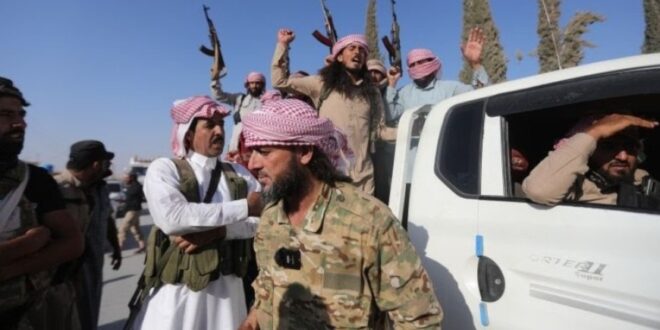The recent attacks by “Tribal and Clan” forces on areas controlled by the SDF have reignited the debate about the nature and affiliations of these forces. Critics of the Autonomous Administration view these groups as Arab forces striving to liberate their territories from PKK control, denying any ties to Iran or the Syrian regime. Conversely, supporters of the Autonomous Administration argue that these forces are an Iranian initiative aimed at destabilizing the region.
The origins of the “Tribal and Clan” forces trace back to September 2023, when Ibrahim al-Hafl announced their formation with the objective of fighting SDF forces and liberating tribal areas east of the Euphrates. Initially, al-Hafl relied on tribal fighters and their military capabilities, achieving some early successes. However, as the SDF reorganized and launched counterattacks, al-Hafl sought additional support, finding an ally in Brigadier General Jihad Al-Zaal, head of the Air Intelligence Branch in Deir-ez-Zor at the time. Al-Zaal provided military support, including ammunition and the transfer of National Defense fighters from regime-held areas west of the Euphrates to join Hafl’s efforts.
After Hafl’s defeat and the fall of Dhiban, his headquarters and hometown, in September, he and his fighters retreated to regime-held areas. Iran then began to cultivate a relationship with Hafl, seeing him as a viable alternative following the failure of their investment in Nawaf al-Bashir, the Sheikh of the Baqqara tribe.
Hafl’s relationship with Iran deepened after his transfer to Damascus, where he met with Iranian leaders, including military personnel from the Iranian Revolutionary Guard and diplomats from the Iranian embassy. They agreed on Iranian military and financial support for Hafl’s campaign against the SDF, with instructions to conceal any overt allegiance to Iran or the Syrian regime to attract more members and maintain the appearance of a local tribal rebellion.
Following the agreement, Hafl worked to rally tribal leaders to his cause, particularly those loyal to Iran. He held meetings with figures like Farhan Al-Marsoumi, Sheikh of Al-Marasema, and Nawaf al-Bashir, as well as military leaders from tribal backgrounds aligned with Iran. This strategic alliance has made Hafl and his forces a significant tool for Iran in the conflict in eastern Syria.
Several points underscore the depth of Hafl’s ties to Iran:
- Political Stance: Since 2011, Hafl has not taken any public stance against the Syrian regime or Iran, nor has he supported the Syrian revolution. His opposition has been solely directed at the Autonomous Administration and its projects.
- Residence and Stronghold: After relocating to regime-controlled areas west of the Euphrates, Hafl has been based in Al-Mayadeen, a key center of Iranian influence in Deir-ez-Zor.
- Operational Base: Hafl’s military operations are launched from Al-Mayadeen and the surrounding areas, which are strongholds of Iranian militias. This logistical support would be impossible without Iranian backing.
- Arms and Ammunition: Hafl’s forces receive their weapons and ammunition from Iran, which also provides financial compensation to the fighters.
- Leadership and Coordination: Iranian militia leaders, such as Hashem Masoud Al-Sattam of the “Lions of the Aqeedat” militia, have led operations alongside Hafl. Sources indicate that even high-ranking Iranian figures, like Hajj Assad, commander of Hezbollah forces in eastern Syria, have been involved in recent attacks.
Iran’s strategic interest in supporting Hafl lies in countering U.S. influence through proxy forces, minimizing its own costs in terms of money and manpower. The weapons used are inexpensive, and much of the funding comes from the illicit drug trade. The fighters, often locals or militias from Iraq, Lebanon, Afghanistan, and Pakistan, bear the brunt of the conflict, while Iranian Revolutionary Guard officers manage operations from behind the scenes, aiming to wear down opposition forces until they collapse or withdraw.
 Eurasia Press & News
Eurasia Press & News


